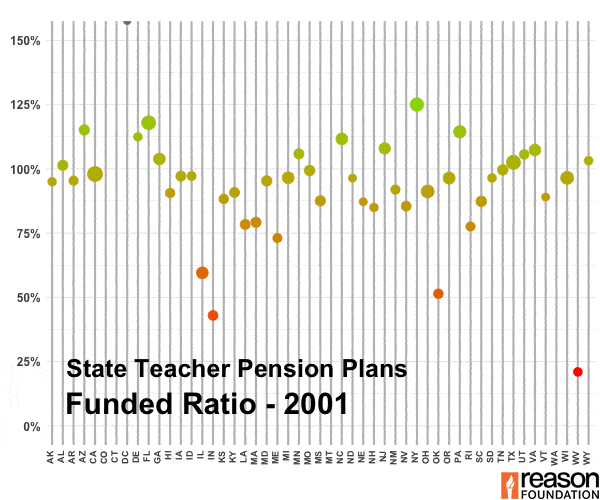This newsletter from the Pension Integrity Project at Reason Foundation highlights articles, research, opinion and other information related to public pension challenges and reform efforts across the nation. You can find previous editions here.
In This Issue:
Articles, Research & Spotlights
- Proposed New Mexico Reforms Are An Important First Step for Solvency
- New York City Faces More Than Just Unfunded Pension Obligations
- Why Changing U.S. Life Expectancies Present Challenge for Pensions
- California Turns to Green Bonds for Innovative Financing
News in Brief
Quotable Quotes on Pension Reform
Featured Graph
Contact the Pension Reform Help Desk
Articles, Research & Spotlights
Proposed PERA Reform Is an Important Step Toward Pension Solvency in New Mexico
As a result of a set of proposed changes from a 2019 task force, New Mexico policymakers are now mulling over a group of reforms that would improve the funding of the state’s Public Employees Retirement Association (PERA). The changes represent an increased level of commitment to the pension system in the form of contribution increases shared equally between both employers and employees, which are estimated to save over $6 billion over the next 25 years. The Pension Integrity Project team has evaluated these proposed changes, concluding in a series of analyses, one-pagers, and commentaries that they would be a clear improvement for PERA’s long-term fiscal standing and serve as the first steps in a needed series of reforms to ensure solvency.
» ANALYSIS: Proposed PERA Reform an Important Step Toward Pension Solvency in New Mexico
» 1-PAGE EXPLAINER: Why PERA Being Only 71 Percent Funded Is Not Enough
» 1-PAGE EXPLAINER: Redesigning Cost of Living Adjustments Would Improve PERA Sustainability
» 1-PAGE EXPLAINER: Does the Proposed New Mexico PERA Solvency Legislation Meet the Objectives for Good Pension Reform?
» COMMENTARY: PAYGO Is the Most Costly Way to Fund a Public Retirement System and Would Be Bad for New Mexico
» COMMENTARY: Stars Have Aligned For Needed Pension Reform, Reason’s Leonard Gilroy in the Santa Fe New Mexican
New York City’s Unfunded OPEB Liability Surpasses $100 Billion
While New York City faces significant public pension funding challenges, their unfunded liabilities for other post-employment benefits (OPEB), at over $100 billion, have taken center stage. Becoming more of a concern for the city’s policymakers and taxpayers, their OPEB unfunded liability grew over $9 billion in the 2019 fiscal year alone. Reason’s Marc Joffe takes a look at the city’s growing OPEB obligations and details some of the contributing factors contributing, suggesting the need to reevaluate the funding policies behind OPEBs.
The Downward Trend in U.S. Life Expectancy and Its Uncertain Impacts on Public Pensions
Recent declines in U.S. life expectancy have certainly grabbed the attention of those managing post-employment life benefits like pensions. But a closer look into emerging trends shows that public pensions are likely less impacted by this development than private-sector retirement plans. Reason’s Marc Joffe explains that, contrary to commonly held belief, public workers tend to live longer from retirement age when compared to their private-working counterparts. The reason for this isn’t perfectly clear, but initial studies suggest that public sector workers are better-educated, which has a strong correlation to mortality rates.
Green Municipal Bond Raises Questions About Pension Fund Borrowing
The California State Teachers Retirement System (CalSTRS) has used unique and innovative methods to generate funding for an extension of its headquarters. Instead of using state financing (the common path for securing funding for such projects), it has issued $273 million in environmentally-friendly green bonds. Reason’s Marc Joffe explains the costs and benefits of green bonds and suggests that in this particular case, the use of such bonds appears to be a net positive for taxpayers.
News in Brief
Paper Discerns Impact of Pension Costs on Teacher Salaries
As public defined-benefit (DB) plans have been steadily increasing debt levels since the financial crisis, the cost related to maintaining public pension plans has continued to increase. This increased cost affects the budgetary decisions of public employers, especially when it comes to teachers’ pay. This paper in the Journal of Pension Economics and Finance notes the impact of increased pension contributions on employee salaries, finding that a 1 percent increase in pension contributions corresponds to a decrease in total teacher salary expenditures of 0.24 percent. The change in total teacher pay tends to express itself in fewer teachers hired. The paper can be found here.
Brief Notes a Shift for Many Pension Funds Toward a “New Normal”
Since the 2008 financial crisis, returns for pension funds have been lower than historical averages, forcing many to shift toward riskier assets such as private equities and real estate. In its third annual brief on the subject, Pew Charitable Trusts shows that many plans have updated their assumed rates of returns in order to better match these new financial conditions. In 2008, the average assumed rate of return was 8 percent. In 2017, the average fell to 7.3 percent. Along with these lowered expectations come increases in annual contributions, which states are having to address. The full brief is available here.
Study Finds Highly Educated Workers Pay Higher Fees for Retirement
Mutual funds are popular among retirees for providing steady returns at low fees. Government employees are enrolled in a defined contribution plan, the Thrift Savings Plan (TSP), which invests exclusively in these mutual funds. However, many workers leaving government work choose to move their savings over to an IRA plan with higher fees. Curiously, the study finds that highly educated workers tend to make this unwise decision at a higher rate. The study is available here.
Quotable Quotes on Pension Reform
“[G]iven that their investments have fared poorly amid strong stock-market performance, it’s a fair bet that many pension plans will continue to fall short of their assumed rates of return in 2020. And state and local policymakers will continue to look for ways to shore up ailing plans without tax hikes or program cuts as they try to deal with the core problem: too much risk and how it’s being shared.”
-Tod Newcombe in “The Biggest Issues to Watch in 2020,” Governing Magazine, January 13, 2020.
“The threat of having to take funds from other vital government services — government services that our state cannot operate without — is real. Pennsylvania isn’t like the federal government. We can’t just print money. We need a new status quo in pension liability that prioritizes working together to find solutions that meet the needs of citizens and, hopefully, sets a bar the other states will be driven to match.”
-Keith Greiner and Seth Grove, Pennsylvania state representatives, in an op-ed, “Why States Must Address Pension Reform Now, Before It’s Too Late,” Washington Times, December 25, 2019.
“Retirement board members start seeing themselves as advocates and representatives of the constituencies that put them on the board rather than as a collective of fiduciaries working for the common goal of funding promised benefits.”
-Harvey L. Leiderman, Partner at Reed Smith LLP, quoted in “Tackling the issue of conflict on public fund boards,” Pension&Investments, January 13, 2020.
“The attraction of POBs [Pension Obligation Bonds] … is that they can superficially look like ‘refinancing,’ but they’re not. The city can use POBs to lower its current payments into its pension plans, but long-term savings are illusory.”
-David Grau, Ventura County Taxpayers Association, on a recent decision by the Simi Valley City Council to borrow in the form of a Pension Obligation Bond, “A risky financing maneuver without a public vote,” VC Star, January 4, 2020.
Featured Graph
Each month we feature a pension-related chart or infographic of interest curated by Pension Integrity Project quantitative analyst Andrew Abbott. This month’s chart displays the funded ratios for the primary teacher retirement plan in each state and how they’ve changed since 2001.
Contact the Pension Reform Help Desk
Reason Foundation’s Pension Reform Help Desk provides information on Reason’s work on pension reform and resources for those wishing to pursue pension reform in their states, counties and cities. Feel free to contact the Reason Pension Reform Help Desk by e-mail at pensionhelpdesk@reason.org.
Follow the discussion on pensions and other governmental reforms at Reason Foundation’s website and on Twitter @ReasonPensions. As we continually strive to improve the publication, please feel free to send your questions, comments and suggestions to alix.ollivier@reason.org.
Stay in Touch with Our Pension Experts
Reason Foundation’s Pension Integrity Project has helped policymakers in states like Arizona, Colorado, Michigan, and Montana implement substantive pension reforms. Our monthly newsletter highlights the latest actuarial analysis and policy insights from our team.


